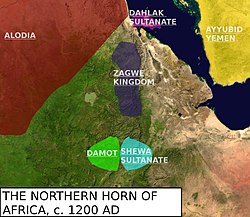TheKingdom of Damot(Amharic:ዳሞት) was an medieval kingdom in what is now westernEthiopia.[1]The territory was positioned below theBlue Nile.[2]Possibly formed in the 10th century, it was a powerful state by the 13th century that forced theSultanate of Showato pay tributes.[3]It also annihilated the armies of theZagwe dynastythat were sent to subdue its territory. Damot conquered several Muslim and Christian territories.[4]The Muslim state Showa and the new Christian state underYekuno Amlakformed an alliance to counter the influence of Damot in the region.[5]
Kingdom of Damot | |||||||||||
|---|---|---|---|---|---|---|---|---|---|---|---|
| c. 10th/13th century–c. 16th century | |||||||||||
 The kingdom of Damot and its neighbours circa 1200 AD | |||||||||||
| Capital | Maldarede 9°23′N37°34′E/ 9.39°N 37.56°E | ||||||||||
| Common languages | Gonga,and otherNorth Omotic languages | ||||||||||
| Religion | Paganism,Christianity | ||||||||||
| Government | Monarchy | ||||||||||
| Motalami | |||||||||||
| History | |||||||||||
• Established | c. 10th/13th century | ||||||||||
• Conquered byEthiopia | c. 1316 | ||||||||||
• Defeated byOromos | r. 14th century | ||||||||||
•16th century(By the 16th century, Damot was further fragmented and ultimately overrun during the larger Oromo expansion) | c. 16th century | ||||||||||
| |||||||||||
Some academics have claimed that Damot was equivalent to theKingdom of Wolaita,with the most famous ruler of Damot,Motolomi Sato,coming from the Wolaita Malla dynasty which ruled from the 13th-16th century, before being replaced by the Tigre Malla dynasty amid theOromo expansion.[6]: 59
History
editThe kings of Damot, who bore the titlemotalami,resided in a town which, according to thehagiographyofTekle Haymanot,was called Maldarede.[7]Damot was conquered by EmperorAmda Seyonin 1316/7. His royal chronicle recounted that "all the people of Damot [came] into my hands; its king, its princes, its rulers, and its people, men and women without number, whom I exiled into another area."[8]: 65 Amda Seyon seemingly left the Damotian royal family in power, for the titlemotälämicontinued to be used until the 15th century.[8]: 71 Al-Mufaddal ibn Abi al-Fada'ilin the 14th century writes that Damot alongsideHarla Kingdomwere forced to pay tribute to Abyssinia.[9]
Damot was originally located south of theAbay Riverand west of theMuger River.[10]However, the kingdom’s decline began in the 14th century, as suggested by some sources, such asPaulos Milkias,who argues that the Oromo conquest of Damot may have started earlier than widely believed.[10]This earlier timeline helps explain whyAba Bahrey,writing in the 16th century, provides little detail about Damot’s fall—it had already been displaced or weakened long before his time.[11]Instead, Aba Bahrey focuses on how the Oromos used the "west," once part of Damot’s territories, as a base for military campaigns, crossing the Abay River to invade theKingdom of Ennareain the "southwest" (modern-dayJimma).[12]
By the late 16th century, under the leadership ofMula'ata Lubas(1586–1594), theMacha Oromooverran Ennarea amid theOromo expansionand forced its clans to flee across the Abay River intoGojjam.Many of these displaced populations settled in the sub-provinces of Bure Damot and Daga Damot, though the Oromos pursued them until they were fully subdued.[10]Unlike other conquering groups, the Oromos incorporated the people they defeated, requiring them to adopt Oromo culture and language. This practice boosted their numbers and facilitated their expansion into the highlands.[10]
Some sources, such as Paulos Milkias, suggest that areas likeWalal(nearMount Tullu WalalinQelem, Wallaga) were inhabited byKafa-descended people known as Busase or Bushasho before the Oromo conquest. Following the fall of Damot, a Christian temple in the region was converted into a church, and descendants of the Busase people continue to inhabit parts ofAnfilo,producing coffee for both local and export consumption.[10]
Their territory extended east beyond the Muger as far as theJamma.[13]The province of Damot remained part of theEthiopian Empirewell after theZemene Mesafintbegan, unlike other southern regions. The ruler of Damot was typically from Gojjam and held the titleRas.
Religion
editThe population of Damot adherred to its own religion dominated by a deity calledDäsk.This continued on even well after being conquered by the ChristianEthiopian Empire,which repeatedly led to conflict between the locals and the Christian garrison troops.[8]: 80 Parts of the population seemingly remained pagan until the late 16th century.[14]
It is claimed in the Hagiography ofTekle Haymanotthat the latter managed to convert the ruler of Damot to Christianity.[15]
References
edit- ^Shinn, David (2013).Historical Dictionary of Ethiopia.Scarecrow Press. p. 111.ISBN9780810874572.
- ^Shillington, Kevin (4 July 2013).Encyclopedia of African History 3-Volume Set.Routledge.ISBN9781135456696.
- ^González-Ruibal, Alfredo (2024-03-01)."Landscapes of Memory and Power: The Archaeology of a Forgotten Kingdom in Ethiopia".African Archaeological Review.41(1):71–95.doi:10.1007/s10437-024-09575-8.hdl:10261/361960.ISSN1572-9842.
- ^Bounga, Ayda (2014)."The kingdom of Damot: An Inquiry into Political and Economic Power in the Horn of Africa (13th c.)".Annales d'Ethiopie.29:262.doi:10.3406/ethio.2014.1572.
- ^Hassen, Mohammed.Oromo of Ethiopia(PDF).University of London. p. 4.
- ^Aalen, Lovise (2011-06-24).The Politics of Ethnicity in Ethiopia: Actors, Power and Mobilisation under Ethnic Federalism.BRILL.ISBN978-90-04-20937-4.
- ^Bouanga 2014,pp. 33–37.
- ^abcAyenachew, Deresse (2020). "Territorial Expansion and Administrative Evolution under the" Solomonic "Dynasty". In Samantha Kelly (ed.).A Companion to Medieval Ethiopia and Eritrea.Brill.
- ^Harla.Encyclopedia Aethiopica.
- ^abcdeMilkias, Paulos (2011).Ethiopia.Internet Archive. Santa Barbara, Calif.: ABC-CLIO.ISBN978-1-59884-257-9.
- ^Hassen, Mohammed (2015).The Oromo and the Christian Kingdom of Ethiopia: 1300-1700.Boydell & Brewer.ISBN978-1-84701-117-6.
- ^Mohammed Hassen (1990).The Oromo of Ethiopia: A History 1570-1860.
- ^G.W.B. Huntingford,Historical Geography of Ethiopia from the first century AD to 1704(London: British Academy, 1989), p. 69
- ^Fauvelle, François-Xavier (2020). "Of Conversion and Conversation: Followers of Local Religions in Medieval Ethiopia". In Samantha Kelly (ed.).A Companion to Medieval Ethiopia and Eritrea.Brill. p. 140.
- ^Lusini, Gianfrancesco (2020). "The Ancient and Medieval History of Eritrean and Ethiopian Monasticism: An Outline". In Samantha Kelly (ed.).A Companion to Medieval Ethiopia and Eritrea.Brill. p. 207.
Further reading
edit- Bouanga, Ayda (2013).Le Damot dans l'histoire de l'Ethiopie (XIIIe-XXe siècles): recompositions religieuses, politiques et historiographiques(in French). Université Panthéon-Sorbonn.
- Bouanga, Ayda (2014)."Le royaume du Damot: enquête sur une puissance politique et économique de la Corne de l'Afrique (XIIIe siècle)"(PDF).Annales d'Ethiopie(in French).29:27–58.doi:10.3406/ethio.2014.1557.